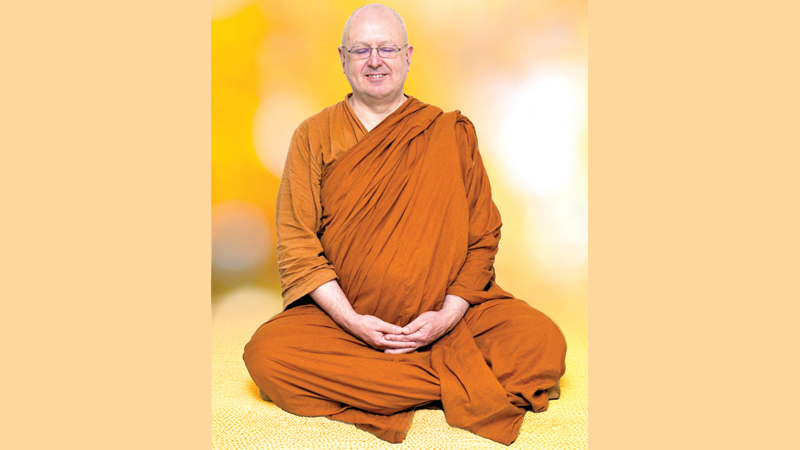Ajahn Brahm’s teachings on meditation are rich with humour and profound insights, focusing on the breath as a gateway to relaxation and inner calm. His approach emphasises taking it slow, being mindful, and having patience—essential ingredients that help practitioners gradually reach a peaceful state.
Here’s how he guides us to deepen our meditation practice through the simple yet powerful act of focusing on our breath.
Starting with preparation
Ajahn Brahm emphasises that breath meditation isn’t something you rush into. You’ve got to ease into it by preparing the mind first. He recommends taking some time to engage in present-moment awareness—just sitting quietly, doing nothing, and letting the mind settle. This stage of preparation helps cut down on distractions and makes it easier to shift into breath meditation when the time is right.
Why present-moment awareness matters
This initial step of embracing silence and present-moment awareness is crucial. Imagine trying to dive into a deep, focused state when your mind is still racing from the day’s activities—it doesn’t work. So, Ajahn Brahm advises us to make sure we’re calm and centered before even attempting to focus on our breath. If we jump into it too quickly, our minds are likely to wander, leading to more frustration than peace.
A gentle approach to breath meditation
Ajahn Brahm’s approach to breath meditation is refreshingly gentle. He advises treating the breath like you would a friend—inviting it into your awareness with kindness, rather than trying to control or force it. If you push too hard, the breath responds by becoming tense and unnatural, much like how a friend might pull away if you’re too controlling. Instead, allow the breath to come and go naturally, and over time, it will settle down on its own.
Letting go of control
Control is often rooted in fear—fear of not meditating the “right” way, fear of not being able to focus, or fear of failure. Ajahn Brahm encourages us to let go of this control and instead relax into the practice. When we release that need to control, the breath stabilises on its own, and meditation becomes more effortless. In his words, “The more you relax, the more naturally the breath will stay.”
Your breath as a friend
Ajahn Brahm encourages us to think of the breath as a friend. If we treat it kindly, it will stick around. But if we treat it like a servant, demanding that it behave a certain way, it’s more likely to slip away. By allowing the breath to come and go freely, we build a relationship of trust and comfort with it, making it more likely to stay with us throughout our meditation.
Natural evolution of the breath
As meditation deepens, something beautiful happens—the breath naturally slows down. This is a sign that both the body and mind are becoming more relaxed. Ajahn Brahm explains that when we allow this process to happen naturally, the breath becomes a reflection of our inner calm. We no longer need to chase the breath or control it; instead, it becomes a simple, peaceful companion.
Finding peace and joy in the breath
Meditation isn’t just about calmness; it’s also about finding joy in that calm. Ajahn Brahm likens the experience to the happiness of being on a peaceful holiday. There’s no rush, no need to be anywhere else.
You’re simply present with the breath, enjoying the simplicity and peace it brings. As you start to appreciate the breath, it becomes a source of joy, just like a beautiful, serene holiday destination.
Wisdom power over willpower
One of Ajahn Brahm’s key teachings is the idea of “wisdom power” rather than “willpower” in meditation. Forcing the mind to concentrate is like trying to push a delicate flower to bloom—it won’t work. Instead, he encourages us to nurture the mind gently, much like caring for a plant, allowing it to grow naturally.
When we meditate with wisdom, we guide our minds with care rather than brute force, leading to a more effortless and enjoyable practice.
The science of breath and relaxation
Ajahn Brahm points out that as we relax during meditation, our body’s demand for oxygen decreases, leading to a slower, more peaceful breath. He compares this state to putting a car in idle—still functioning, but conserving energy. The result is a deep, restful state of relaxation, both mentally and physically.
The joy of simply being with the breath
At the core of Ajahn Brahm’s meditation teaching is the joy of simply being. When we stop striving and let ourselves just be with the breath, meditation transforms into a relaxing retreat. It becomes a true holiday from the stresses of daily life—a moment of deep rest and rejuvenation that we can access anytime we sit down to meditate.
Teaching meditation to children
Ajahn Brahm also touches on introducing meditation to children, using imagination as a tool to help them find their own inner peace.
Through creative visualisation, children can tap into their calm, no matter what’s happening around them. Imagination, in this case, becomes a gateway to mindfulness, even for the youngest meditators.
Enjoying the journey
Ultimately, Ajahn Brahm reminds us that meditation is a journey to be enjoyed, not a task to be completed. With relaxation, patience, and wisdom, it becomes a source of peace and joy—a space where we can let go of our worries and just be.
****
Join Ajahn Brahm in Sri Lanka – May 2025
Ajahn Brahm will visit Sri Lanka in May 2025, bringing his wisdom and humour to a wider audience. He will deliver a public sermon at the BMICH on May 18. This is a rare opportunity to experience his teachings first hand and deepen your meditation practice under his guidance.









